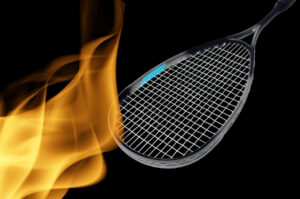If you wonder what size is L1 in a tennis racket and what it means – you just came to the right place!
In the following, you will find a detailed explanation as to what size is an L1 racket and what it means.
Let’s get started!
How do I know what size racket you need?
The circumference around the edge of the handle is used to determine racket grip sizes. The
measurement for this circumference is taken in the middle of the racquet handle.
The sizes vary from 4 inches to 4 3/4 inches.

How grip size is determined?
The most common way to determine grip size is by using a ruler.
To use the ruler test to determine grip size, hold your racket hand fingers together then line up a ruler with the crease at the bottom of your palm (to be precise: the second line on your palm).
To find your grip size, measure from the bottom of your palm to the tip of your ring finger.
Where can you find the grip size on your tennis racket?
If you take a look at the bottom of your racket’s handle, there should be a number between 0 and 5. This is the grip size of your racket.
What size is L1 in my tennis racket?
Did you know that the United States uses inches to list grip sizes, while most other places use numbers? As a result, your endcap might say “1” or “L1/G1′ instead of “4 1/8”! But don’t worry, they’re the same size.
Once you have determined your grip size, you can then use the following chart to determine what size is L1, L2, L3, L4, and L5.
If your US grip size Length is 4″ (4 inches) = Your European Grip size is 0 (L0 or G0).
If your US grip size Length is 4 1/8 inches = Your European Grip size is 1 (L1 or G1).
If your US grip size Length is 4 1/4 inches = Your European Grip size is 2 (L2 or G2).
If your US grip size Length is 4 3/8 inches = Your European Grip size is 3 (L3 or G3).
If your US grip size Length is 4 1/2 inches = Your European Grip size is 4 (L4 or G4).
If your US grip size Length is 4 5/8 inches = Your European Grip size is 5 (L5 or G5).
What is the most common tennis grip size?
The most common grip size in tennis is 3 or 4 3/8.
There are differences between women and men in grip sizes.
A size 1, 2, or 3 grips is the most common among women players, while a size 3, 4, or 5 is the most common among men.
What are L1, L2, L3, L4, and L5 in tennis racket sizes?
L1, L2, L3, L4, and L5 are different grip sizes of the tennis racket handle.
The higher the number (L5), the larger the racket’s handle.
The smaller the number (L0), the smaller the handle.
How do you know if a tennis racket fits you?
Comfortable grip size is one where your fingers don’t touch your hand when gripping the handle.
You’ll need a big enough handle so that there is some distance between your fingertips and your hand.
If your fingers wrap completely around the handle and then slip back into your hand, you’ll need a bigger grip size.
Keep in mind that determining grip size is not a precise science. If you are stuck between two sizes, it is always best to go for the smaller option.
Is a bigger grip size better for tennis?
If a tennis racket has a grip that’s too large, the player won’t be able to snap their wrist on serves as easily, making it more complicated to change grips and additionally demanding extra muscle strength.
Larger grip sizes are more suited to shots that demand greater power, but they will restrict the wrist’s mobility.
You will have less control over the ball if you absorb more impact, which will lead to putting greater strain on your wrist and elbow muscles and tendons.
Is a small grip size better for tennis?
A racquet with a too-small grip needs more arm strength to prevent it from turning in your grasp.
If you frequently use a grip that’s too small, it could lead to tennis elbow problems.
In conclusion
The size of your racket’s grip will affect your play, so it is important to choose the right grip size for you.
The most common grip size in tennis is 3 or 4 3/8.
If you are stuck between two sizes, it is always best to go for the smaller option.
Comfortable grip size is one where your fingers don’t touch your hand when gripping the handle.
You’ll need a big enough handle so that there is some distance between your fingertips and your hand.
If your fingers wrap completely around the handle and then slip back into your hand, you’ll need a bigger grip size.
Keep in mind that determining a grip size is not a precise science.
If a tennis racket has a grip that’s too large, the player won’t be able to snap their wrist on serves as easily, making it more complicated to change grips and additionally demanding extra muscle strength.
Larger grip sizes are more suited to shots that demand greater power, but they will restrict the wrist’s mobility.
You will have less control over the ball if you absorb more impact, which will lead to putting greater strain on your wrist and elbow muscles and tendons.
A racquet with a too-small grip needs more arm strength to prevent it from turning in your grasp.
If you frequently use a grip that’s too small, it could lead to tennis elbow problems.
Choosing the right grip size is important to playing your best game.
I hope you enjoyed this comprehensive guide.
If you have any further questions, please feel free to leave a comment below. 🙂
Don’t forget to check out my other blog posts for more informative guides.
I hope you will choose the right grip size for you and check back on my website soon for more posts!:)








